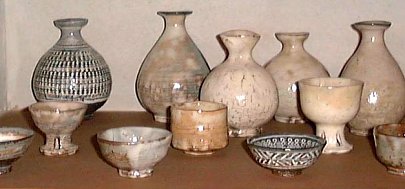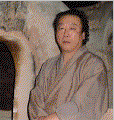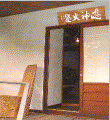|

Yellin's gallery
sells pieces from
the kilns of Japan's
finest potters |
|
|
POTTER SPOTLIGHT (12 Photos)
Takahashi Samon - A New Discovery
 |
It's safe to say that many folks around the world all discovered something within the last few months. This new unearthing was possibly something inside the heart or maybe in one's home or community.
In the ceramic community here in Japan there are many yet-to-be-made discoveries of energetic new talent or of even quiet veterans. I'm going to highlight some of these creative talents and offer their works in a new page for e-y net and japanesepottery.com titled "Potter Spotlight."
My first discovery actually happened many years ago. Yet for J'pottery enthusiasts around the world I don't think they've unturned that stone yet. There are quite a few unheralded potter gems in this country and without a doubt one of them is Takahashi Samon (1948-).
This past week I rode the bullet train down to Nagoya and then changed to a local line to visit Takahashi-sensei (teacher, master). It was the first time I'd seen him in about five years. About ten years ago was the first time I had touched any of his kofuki (a.k.a. kohiki -- more on that later) wares and I've never forgotten them. There was an immediate noticeable difference from other contemporary, and ancient, kofuki wares that mostly seemed to be a milky white slip fired ware. Of course that's what most kofuki wares are, an iron rich clay covered over with slip and then a translucent glaze. The style comes from Korean punch'ong wares (paekt'o punch'ong in Korean). The most famous kohiki chawan in Japan is named "Matsudaira" and is in the collection of the Hatakeyama Memorial Museum of Art. It shares much in character with Takahashi's kofuki.
|
The photos below are from my recent visit. The photo of Mt.Fuji was taken from the bullet train on my way back. Click any image to see the full-size photo.
|
|
|

|

|

|
|
Mt. Fuji
|
Samon's Garden
|
Samon Himself
|
|

|

|

|
|
His Kiln
|
Samon Kiln Sign
|
Shuki Pieces
|
|

|

|

|
|
Showroom Entrace
|
More Shuki
|
Shuki and Chawan
|
|

|

|

|
|
Tokkuri Drying
|
Vats
|
Samon Writing
|
|
Takahashi first saw a kohiki piece at age 21. He was in Nagoya after recuperating from an operation and visited a museum. There he encountered a Korean Yi dynasty kohiki jar and something was set aflame in his heart.
Takahashi prefers to call his pottery kofuki and not kohiki. Kohiki gets its name from the soft powdery feel of the slip that looks like it's been blown on across the surface. He doesn't think this name and feeling suits his work. For him the distinctive feel in his work comes from the inside, born out of the clay so to speak and his alchemist-like glazes; it's not a superficial thing. Takahashi explained to me that kobuki means to be born from within, while, as mentioned above, the term kohiki only scratches the surface. Both terms are fine for white slip wares and are found in Kato Tokuro's ceramic dictionary.
Around the hills of Takahashi's studio is where he digs some of his clay; the rest is purchased from clay brokers in the Mino region or other areas of Japan. Right now he's using about six different clays and each has its own characteristic and personality. He told me that where the clay comes from is of no concern. Unlike Bizen or Hagi where they usually only use a few different varieties of clay, Takahashi wants to fire the earth. It makes no difference where it comes from as long as it meets his needs.
Same for the more than twenty types of slips he uses. That's right, that many. He said he could make even more if he only had the space. His more than a quarter century of firing and testing has given him the experience and knowledge to get the kinds of brilliant effects that only he knows how. Unlike purely white kohiki wares, Takahashi wants to broaden the color scheme and create what he can call his own kofuki. He has. Deep crackles called kannyu are found on his works along with his magnificent range of colors he gets from mixing and matching slip and tomei-yu (translucent glaze); they are both simply stunning. The slip is put on especially thick. His kannyu is part of the beauty of the work and do not leak. A few visitors to his exhibitions express concern about that---no need to though.
Firing takes place in a three chambered noborigama; all the pieces are fired in saggars for between thirty-six and forty hours at a peak temperature of between 1230-1240 degrees Celsius.
Takahashi makes the whole range of traditional Japanese forms. For the table or the tea room, his work is fresh, dignified, pleasant, easy to live with and use, and a joy to gaze upon. A Korean visitor to one of Takahashi's exhibitions expressed amazement and was in awe of this new kofuki style. He gave Takahashi the ultimate compliment saying he had given new life to this ancient style.
Takahashi first studied with Kato KobeeV and Kato Takuo(the current Living National Treasure for three colored wares). He then entered the Gifu Prefectural Ceramic Institute to study kilns and then to Kamakura for an apprenticeship at Rosanjin's kiln known as Kamakura Toubo. He established his kiln in 1977 and named it Tenshou-gama or "Soaring Towards Heaven." His father chose the name and it expresses the feeling Takahashi got while watching white herons glide by his window near his first kiln.
Exhibitions are held at Mitsukoshi in Tokyo, Maruei in Nagoya, and Hankyu in Osaka.
|
|
|